Windows 11 Quick Machine Recovery in Canary Build

Microsoft has begun rolling out a new Quick Machine Recovery (QMR) feature in the latest Windows 11 Canary build. Designed to automatically diagnose and remediate severe boot failures, QMR extends the familiar Windows Recovery Environment (WinRE) with network connectivity, secure update plumbing, and scripted repair logic—enabling PCs that can’t start normally to self-heal via Microsoft’s servers.
Overview of Quick Machine Recovery
Initially announced in late 2024 under the Windows Resiliency Initiative, QMR is a direct response to the mid-2024 CrowdStrike update outage that left millions of desktops and servers unbootable. By booting into WinRE over UEFI Secure Boot and downloading targeted patches or rollback scripts, QMR ensures that widespread failures can be fixed at scale without manual intervention.
- Boots into a minimal WinRE image with full network stack (IPv4/IPv6, TCP/HTTPS).
- Authenticates to Microsoft Update servers over TLS 1.3, verifying code signatures.
- Downloads and applies hot-patch CABs or PowerShell recovery scripts.
- Reboots into repaired Windows volume or falls back to snapshot-based rollback.
Technical Architecture
Under the hood, QMR leverages the existing WinPE bootloader chain with custom extensions:
- UEFI Secure Boot: Ensures only signed QMR binaries execute.
- Network Initialization: Drivers for wired/Wi-Fi NICs, DHCP, DNS resolution.
- Recovery Agent: A WinRE plugin written in native C++ and PowerShell Core 7.x.
- Update Channel: Differential CAB packages served via Azure CDN for minimal download size.
- Rollback Snapshots: Uses Volume Shadow Copy Service (VSS) to revert to pre-update state if repair fails.
Recovery Agent and Update Server Communication
The QMR recovery agent communicates with microsoft.com endpoints using TLS-encrypted REST APIs. A JSON-based manifest lists available fixes, each signed with Microsoft’s code-signing certificate and validated against the on-device certificate store before execution.
Security and Privacy Implications
Security researchers note that QMR’s remote-fix model must balance convenience with attack surface exposure. By confining recovery logic to WinRE and enforcing certificate pinning, Microsoft reduces the risk of man-in-the-middle tampering. However, enterprise admins can disable QMR via Group Policy or Mobile Device Management (MDM) controls if they prefer on-premise recovery workflows.
“By isolating recovery in WinRE and forcing signed updates, QMR strikes a good balance between automation and security,” says Jane Patel, Principal Security Architect at Sentinel Labs.
Integration with Windows Servicing Model
QMR is delivered as part of preview build 27898 on the Canary channel and will promote through Dev, Beta, and Release Preview before general availability. Under the shared servicing branch model for 24H2 and 25H2, QMR code is already staged on existing systems but disabled. When Windows 11 25H2 ships (expected October 2025), the feature will simply flip on via a lightweight enablement package.
Comparative Analysis and Future Directions
Other operating systems offer similar internet-recovery modes—macOS Internet Recovery and some Linux distributions’ netboot installers—but QMR’s tight integration with WinRE and Windows Update CDN is unique in the PC ecosystem. Looking ahead, Microsoft plans to add AI-driven diagnostics, Azure-hosted rollback snapshots, and an MDM API for custom recovery scripts.
Deployment Timeline and Insider Program
Current Canary participants (build 27898+) can enable QMR under Settings > System > Recovery > Advanced startup. As Microsoft gathers telemetry and expert feedback, we expect a Dev-channel release by August 2025, Beta by September, and inclusion in the Windows 11 25H2 annual update later this year. Organizations can preview QMR in volume licenses using the Windows Insider Enterprise program.